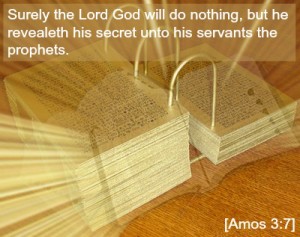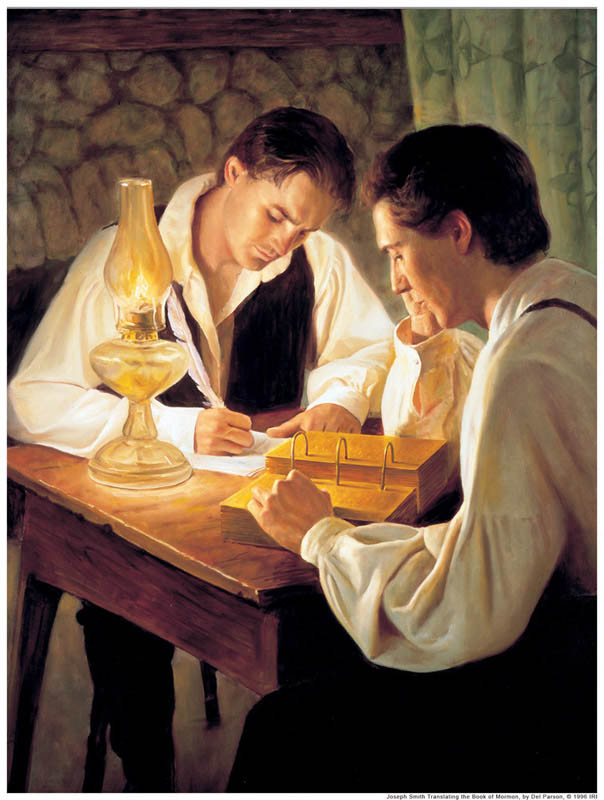Joseph Smith and Seer Stones
Most of the descriptions of the process of translating the Book of Mormon: Another Testament of Jesus Christ have been provided by those who helped the prophet, Joseph Smith, as scribes. Joseph would translate aloud, and the scribe would write down what he said. Joseph did explain the use of the Urim and Thumim (in Hebrew, “lights and perfections”). The Urim and Thummim were essentially seer stones used in Old Testament times, and surely before and after. They were mounted on a “bow” secured to a breastplate, and are described as part of the sacred clothing of Aaron, the brother of Moses. They were handed down from prophet to prophet and found by Joseph Smith in the stone box which contained the gold plates from which he translated. Thus, a way was provided for translation along with the record itself. As far as use for translation was concerned some Jewish scholars claim one of the two stones showed the word in translation and the other showed its meaning. Others say the stones were oracles that provided a yes or no answer. [1] Joseph also possessed a single seer stone, still in the possession of The Church of Jesus Christ of Latter-day Saints, often inadvertently called the Mormon Church. [2] It appears that Joseph only used the stones until he was proficient at receiving direct revelation from God ((Report of) “Two Days’ Meeting at Brigham City June 27 and 28, 1874,” Millennial Star 36:32, August 11, 1874, 499).
 Joseph’s wife, Emma Hale Smith, served as his scribe for a time, and she reported in 1870, “Now the first that my husband translated was translated by the use of Urim and Thummim, and that was the part that Martin Harris lost. After that he used a small stone, not exactly black, but was rather a dark color . . . ” [2] Oliver Cowdery served the longest as Joseph’s scribe and defended Joseph in 1830. “Oliver Cowdery ‘testified under oath, that said Smith found with the plates, from which he translated his book, two transparent stones, resembling glass, set in silver bows. That by looking through these, he was able to read in English, the reformed Egyptian characters, which were engraved on the plates.’” [2] He also said, “Day after day I continued uninterrupted to write from his mouth, as he translated with the Urim and Thummim, or, as the Nephites would have said, ‘Interpreters,’ the history or record, called the book of Mormon.” [2]
Joseph’s wife, Emma Hale Smith, served as his scribe for a time, and she reported in 1870, “Now the first that my husband translated was translated by the use of Urim and Thummim, and that was the part that Martin Harris lost. After that he used a small stone, not exactly black, but was rather a dark color . . . ” [2] Oliver Cowdery served the longest as Joseph’s scribe and defended Joseph in 1830. “Oliver Cowdery ‘testified under oath, that said Smith found with the plates, from which he translated his book, two transparent stones, resembling glass, set in silver bows. That by looking through these, he was able to read in English, the reformed Egyptian characters, which were engraved on the plates.’” [2] He also said, “Day after day I continued uninterrupted to write from his mouth, as he translated with the Urim and Thummim, or, as the Nephites would have said, ‘Interpreters,’ the history or record, called the book of Mormon.” [2]
Some have derided Joseph Smith by saying he put his seer stone into a hat and hid his face in it to exclude the light. To some this sounds clownish enough to discredit him as a prophet, but this report came from David Whitmer, who never did witness the process of translation, so it is unreliable at best. The translation process took effort, and when Oliver Cowdery tried it, he failed, because he expected to receive without that effort. Said Mormon scholar Stephen D. Ricks:
“…the means at Joseph’s disposal (the seerstone and the interpreters) enhanced his capacity to understand the basic meanings of the words and phrases of the book as well as to grasp the relation of these words to each other. However, the actual translation was Joseph’s alone and the opportunity to improve it in grammar and word choice still remained open. All who have had experience in translating are aware of the often considerable cleavage between being able to construe a sentence and actually rendering it in a felicitous translation. All who have translated are also keenly aware that it is a rare translation which cannot be improved. Thus, while it would be incorrect to minimize the divine element in the process of translation of the Book of Mormon, it would also be misleading and potentially hazardous to deny the human factor.” [2]
Corrections to The Book of Mormon?
Of course! The Book of Mormon came forth in essentially one long run-on sentence. Joseph had only about 3 years of primary school education, and his wife Emma said he could barely compose a proper sentence when he was called by God to be the prophet. His remarkable growth over the years amazes those who read his history. Though unschooled, he not only had a superior intellect, but was taught thoroughly from On High, and brought forth knowledge more profound than any other earthly philosopher or religious leader, and brought forth more scripture than any other prophet who has ever lived. Some who deride Joseph and The Church of Jesus Christ exclaim that there have been 4,000 changes made to the Book of Mormon. Since there were originally no chapters or verses in the sacred text, we would reply, “Is that all?”
How Long Did It Take to Translate the Book of Mormon?
Some claim that Joseph Smith wrote the Book of Mormon himself, while others claim he plagiarized parts. These claims were debunked long ago, but still rear their ugly heads. With virtually no resources available in the frontier, and with such little education, how long would it take Joseph Smith, who was constantly in flight from continuous persecution, and who had huge challenges at home (including the death of a child, illness of his wife, stolen pages of the manuscript), to write or to plagiarize the book (531 pages)? Joseph’s wife Emma testified that Joseph never had any other text with him when he translated.
Joseph translated most of the book between April 7 and June 30, 1929. Before that, it had taken him a considerable amount of time to complete the first 116 pages, which were “borrowed” and then lost by Martin Harris. Joseph did not re-translate those pages, because the Lord provided like material in another part of the plates, foreseeing the situation.
The translation was a staggering achievement. It was completed within eighty-five days, from 7 April to 30 June. Of course, not all of that time was spent working on the translation. The Prophet and his scribes also took time to eat, to sleep, to seek employment (once, for money when supplies ran out), to receive the Aaronic and Melchizedek priesthoods, to make at least one (and possibly two) trips to Colesville, thirty miles away, to convert and baptize Hyrum and Samuel Smith (who came to Harmony at that time); to receive and record thirteen revelations that are now sections of the Doctrine and Covenants; to move from Harmony to Fayette; to acquire the Book of Mormon copyright; to preach a few days and baptize several near Fayette; to experience manifestations with the Three and Eight Witnesses; and to begin making arrangements for the Book of Mormon’s publication. [3]

The Book of Mormon Translation Could Only Have Been Accomplished with God’s Help
From the surviving portions of the Original Manuscript it appears that Joseph dictated about a dozen words at a time. Oliver would read those words back for verification, and then they would go on. Emma later added that after a meal or a night’s rest, Joseph would begin, without prompting, where he had previously left off (The Saints’ Herald 26 [Oct. 1, 1879]:290). No time was taken for research, internal cross-checking, or editorial rewriting. In 1834 Oliver wrote: “These were days never to be forgotten-to sit under the sound of a voice dictated by the inspiration of heaven, awakened the utmost gratitude of this bosom! Day after day I continued, uninterrupted, to write from his mouth as he translated” (Messenger and Advocate 1 [Oct. 1834]:14). [4]
Internal Proofs of the Book of Mormon
Yes, there are archaeological proofs for the Book of Mormon, and those increase in number all the time. But there are remarkable internal proofs as well. The perfection of geographical references, consistency in the use of names, and Hebraic poetic style are just a few:
…circumstantial evidence in the English text suggests that the translation was quite precise. For example, the independent and identical translations of 1 Nephi 1:8 and of Alma 36:22 (precisely quoting twenty-one of Lehi’s words in 1 Nephi 1:8) typify the internal accuracy manifested in this long and complex record. Moreover, several formulaic terms, Hebraisms, stylistic indications of multiple authorship, varieties of parallelism and extended chiasmus (see Book of Mormon Authorship; Book of Mormon Literature), as well as certain Semitic proper names and some textual variants, not at all evident from the King James Bible, corroborate the claim that the translation was faithful to a consistent underlying text. [4]
Additional Resources: Read the Book of Mormon online
http://youtu.be/ByJY-N85i7s http://youtu.be/CCdiiSqqp60
